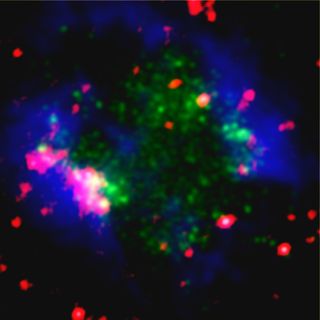Galaxies in the Early Universe Were Less-Than-Stellar Star Makers

Star formation occurring in galaxies just after the Big Bang may not have been as efficient as it is today.
Two nearby galaxies have provided windows into galaxy formation in the early universe, suggesting that star formation was far less plentiful than scientists currently think. With low concentrations of elements other than hydrogen and helium, the relatively nearby collections of galaxies resemble those that thrived when the universe first began. By studying the galaxies Sextans A and ESO 146-G14, a team of astronomers have concluded stars in the early universe didn't form as easily as stars today.
"In the early universe, the very first stars may have formed at much lower efficiencies than what we learned from spiral galaxies such as our Milky Way," principal investigator Yong Shi, of Nanjing University in China, told Space.com via email. [Gallery: 65 All-Time Galaxy Hits (Photos)]
Stunted star formation
Studying galaxies involves looking back in time. Light leaving a distant object takes one year to travel the distance of one light-year, so examining an object 10 light-years away means that you see it when the light left it, 10 years ago.
The first galaxies, which formed nearly 14 billion years ago, lie nearly 14 billion light-years away. This makes them a challenge to observe in detail.
"There are only a handful of very early galaxies that are detected," Shi said. "Detailed properties of these galaxies are largely unknown, because the current telescopes are still not powerful enough for these far-distant galaxies."
According to Bruce Elmegreen, of the IBM T.J. Watson Research Center in New York, star formation processes are thought to be about the same in early galaxies as in modern ones. However, these processes are not well understood.
Get the Space.com Newsletter
Breaking space news, the latest updates on rocket launches, skywatching events and more!
Elmegreen, who was not part of the research, authored a perspective piece that appeared alongside Shi's research. The two were published this week in the journal Nature.
To investigate star formation rates from long ago, Shi and his team turned the ESA's Herschel and NASA's Spitzer infrared space telescopes toward closer galaxies with similar properties. Sextans A is a dwarf irregular galaxy a scant 4.5 million light-years from the Milky Way, while ESO 146-G14 lies 73 million light-years away. The team also used far-ultraviolet images from the NASA's GALEX Space Telescope archive.
Newly formed stars radiate in the far-ultra violet wavelengths of light. Some of that radiation may be absorbed by dust around them and be re-emitted in the infrared. Star-forming regions are characterized by their higher far-ultraviolet and infrared surface brightness compared with regions around them.
The team identified seven star-forming regions inside the two galaxies. They found that stars formed at less than a tenth of the efficiency of stars in galaxies today, leading them to conclude that star formation in the first galaxies may have been similarly stunted.

Not-so-heavy metals
After the Big Bang occurred nearly 14 billion years ago, hydrogen dominated the early universe. It served as the sole ingredient for the first stars, which cooked up other elements in their cores and sprayed them across the universe when they suffered an explosive supernova death. As a result, the first galaxies contained mostly hydrogen and helium, with very few other elements, known to astronomers as "metals."
Galaxies can have very different metallicities, ranging from several times that of the sun, or super-solar, to about 1/50 solar.
"Spiral galaxies in our current universe, like our Milky Way, have a typical metallicity that is solar," Shi said. "These galaxies are the basis where astronomers learn about star formation efficiencies." [How Much Do You Know about the Milky Way? Take Our Quiz]
Sextans A and ESO 146-G14 both have lower metallicities than most other nearby galaxies. Both boast less than 10 percent of what is considered the "normal," or solar, metallicity. Scientists only know of about 100 galaxies that have metallicities that low.
The low metallicity of the galaxies could account for the low star formation rates, both Shi and Elmegreen said.
Stars form when a cloud of gas collapses in on itself due to gravity. But as the cloud contracts, it heats up.
"For collapse to continue, the heat needs to be taken away," Shi said. "Metals, as well as dust and molecular gas, cool by radiation."

In galaxies short on metals, such as the two observed and those in the early universe, the gas clouds may not cool down rapidly enough, making star formation far less efficient than it is today, when metals are more abundant.
Shi said that some theoretical models produce too many stars compared with the galaxies observed in the early universe. The reason may well be that they assume the same type of efficiency in star formation as galaxies today. The new findings suggest that lower metallicity plays a role in stunting the birth of stars.
"We need to modify our theories of star formation, because the inefficiencies were not expected for the right reason," Elmegreen said. "It also means we have to modify our theories about how molecules form, and perhaps our understanding of the molecular abundances in the galaxy … The Shi et al. result was surprising, so we have more work to do."
Follow us @Spacedotcom, Facebook and Google+. Original article on Space.com.
Join our Space Forums to keep talking space on the latest missions, night sky and more! And if you have a news tip, correction or comment, let us know at: community@space.com.

Nola Taylor Tillman is a contributing writer for Space.com. She loves all things space and astronomy-related, and enjoys the opportunity to learn more. She has a Bachelor’s degree in English and Astrophysics from Agnes Scott college and served as an intern at Sky & Telescope magazine. In her free time, she homeschools her four children. Follow her on Twitter at @NolaTRedd
